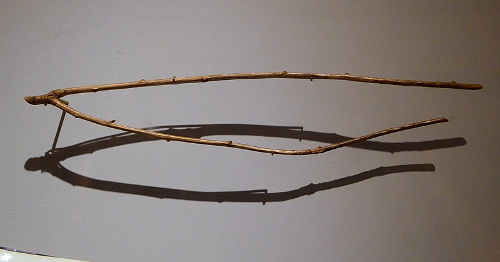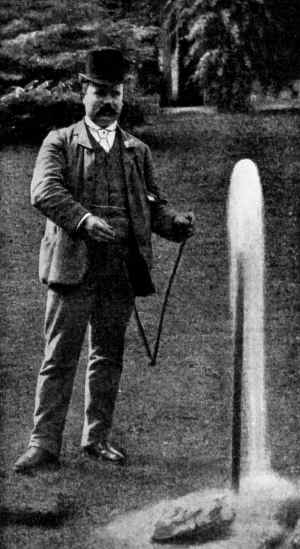
I first learned of dowsing rods when I drove past a farm and saw a man slowly walking around his land with two metal rods in his hand. Curious about what he was up to, I decided to find out for myself.
What are dowsing rods? Dowsing rods are wooden or metal rods that are used for dowsing, a form of divination used to locate various objects. Dowsing is most commonly used to locate groundwater. But also to find oil, gemstones and ores, buried metals, and even gravesites.
In this article, you’ll learn all about dowsing rods and dowsing. I’ll explain what dowsing rods are used for, what materials they’re made of, and more.
The History of Dowsing
Dowsing is believed to have begun in the 16th century in Germany where it was known as a wünschelrute or “wishing rod.” The practice was originally used to find metals in the ground.
In the 19th century, dowsing was brought to America by homesteaders and farmers, who used the technique in an attempt to locate the best places to put water wells on their land. When used to find water, dowsing is sometimes referred to as “witching” for water.
During the Vietnam war, some US Marines even attempted to use divining rods to find tunnels and weapon caches of the Viet Cong.
In modern times, the practice of dowsing has mostly fallen out of favor. Nowadays, water engineers can use technology like seismic water finding to locate water. A sound wave is sent into the ground, and the returning signal is picked up by an antenna array to map out depth and thickness data. However, some farmers still rely on dowsing to find water sources today, particularly in the UK.
Some water companies in the UK even use dowsing to locate damaged pipes. Although this practice has come under more intense scrutiny in recent years.

Source: Florida Memory
What Are Dowsing Rods Used For?
Dowsing can be theoretically used to locate any materials or objects you want.
By far, dowsing rods (also known as divining rods) are most commonly used to find water or sometimes oil. But you can also use them to locate precious metals like gold, silver, or platinum. As well as base metals like iron. In the past, dowsing has even been used in an attempt to locate bodies.
What Are Dowsing Rods (Divining Rods) Made Of?
Dowsing rods or divining rods come in two major types. Y-Rods and L-Rods.
Y-Rod Dowsing Rods
Y-Rods are the more traditional and older type of dowsing rod. They’re made from a wooden branch of a tree or bush that has a y-shaped fork in it.
Any type of wood can be used for divining, but some dowsers may have their own personal preferences. Some insist that the branch needs to be freshly cut and still alive. Others may have a favorite dowsing rod that they always use. Most dowsers will hold their dowsing rod palms down, but some may also do it palms up.
Hazel, peach, and willow trees are some of the most popular types used for dowsing. In fact, dowsing is sometimes also referred to as “willow witching.”
When using a Y-rod, you hold one of the forked parts of the branch in each hand. The stem or point of the branch faces away from you and acts as the detector.
Once a dowser is holding the dowsing rod, they can start to walk around to look for the resource they’re trying to locate, usually water. The dowsing rod should begin to make twitching motions or dip down toward the ground when water is nearby.
L-Rod Dowsing Rods
L-Rods are the more modern type of dowsing rods, and weren’t really used as much until the 19th century.
L-rods are usually a couple of L-shaped thin metal rods. They’re bent at 90 degrees with a shorter part for the dowser to hold on to, and longer ends that can swing freely. Some dowsing rods are also made of plastic or glass.
A dowser holds one of the rods in each hand, and then similarly walks around the land to locate whatever resource they’re looking for. When the resource they’re looking for is nearby, the two rods should cross over each other. If the dowser is looking for a larger object like a water pipe, the rods may orient themselves away from each other. This is to show which way the pipe is oriented.

How Do Believers Explain That Dowsing Works?
There’s no one clear answer as to how or why dowsing works.
Most people who believe in dowsing or use it are often happy to admit that they don’t know how or why it works. They just know that it does seem to work, so they keep using it.
Some dowsers claim that dowsing works because of magnetism or “earth rays.” Others believe it’s a type of witchcraft, or that some kind of clairvoyant ability is involved and that some people are more sensitive to it than others.
Early scientists attempted to find what caused dowsing to work. But their research only found that nothing seemed to induce dowsing rods to move over metal or water. So it was theorized that there must be something about the human holding the dowsing rod that causes it to work.
Various things have been suggested to prevent dowsing from working. This can range from things like rubber shoes, wool or silk gloves, or even tight bandages on the arms.
A Skeptical Explanation of Dowsing
Skeptics insist that dowsing is pseudoscience and that there’s no evidence that using dowsing is any more effective than random trial and error.
When put to the test under scientific conditions, dowsing doesn’t appear to produce any results that are higher than simply random chance. Many dowsers may subconsciously know that certain terrain has a higher chance of having water.
This can lead to an ideomotor response, where the dowser unconsciously moves the rods through involuntary movements. In this way, it’s quite similar to using a pendulum, ouija board, or other similar methods of divination which rely on the ideomotor response.
Several dowsing machines or technologies are on the market which claim to operate on a similar principle to more traditional dowsing. However, any of these which have been tested have also been disproven by science.
Want To Try Dowsing Rods For Yourself?
If your mind isn’t made up on whether dowsing is real or not, why not give it a try yourself?
It’s quite an inexpensive and safe thing to put to the test.
All you need to do is find a Y-shaped branch or stick. Or alternatively, you can bend a couple of metal coat hangers to create L-shaped dowsing rods.
If you give it a try, be sure to let us know in the comments how it worked for you!
Related Questions
Q: Can dowsing rods be dangerous?
A: Some deeply religious people believe that dowsing is a form of magic or witchcraft and that by holding on to dowsing rods, you allow the Devil to work through you. If you’re a very devout Christian and hold this belief, you probably want to pass on giving dowsing a try for yourself. But most divining rod users don’t believe any dangerous spirits are involved or attracted to using them. To most non-religious people, the most significant danger of using dowsing rods may be tripping and falling if you are too focused on the rods and not watching where you’re going!
(Want to learn more about the devil? Check out our article — “Do Satanists Worship The Devil?”
Q: Where can I buy dowsing rods?
A: You probably won’t be able to find dowsing rods in regular stores. They are fairly easy to make yourself just from a Y-shaped stick or some metal coat hangers.
But if you want to buy a dedicated set of dowsing rods that looks and feels more professional, I would recommend buying this one (will open an Amazon link in a new window.) It has over 600 reviews and a 5-star rating, plus it comes with a free pendulum and written instructions on how to use it as well!
Conclusion
Dowsing rods and dowsing have a long history of being used to locate hidden underground resources, especially water and metals.
Dowsing has been labeled as pseudoscience by scientists and has repeatedly failed to perform better than random chance when put to the test. But dowsers still choose to believe and hold on to this ancient technique. They don’t necessarily care how or why it works. They just know that it seems to work for them.
Do you believe dowsing is real? Why or why not? Have you given it a try for yourself?